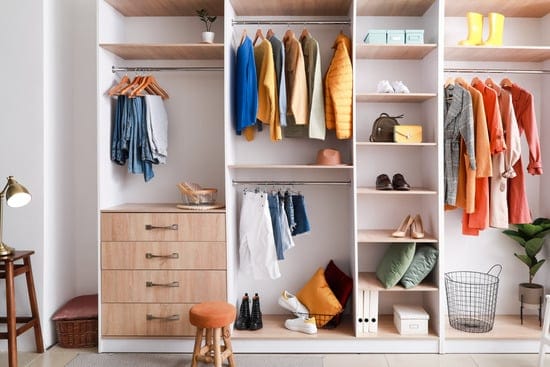Are you tired of your messy, disorganized closet? It’s time to take control and create a functional storage space with a closet organizer. In this article, we will guide you through the process of building your very own closet organizer. By following our step-by-step instructions and using the right tools and materials, you’ll be able to transform your cluttered closet into an organized oasis. Get ready to declutter and optimize your storage space for a safer and more efficient living environment.
Assessing Your Closet Space
Assessing your closet space is crucial before building a closet organizer. To ensure safety and maximize storage, it’s important to start by using proper measuring techniques. Begin by measuring the dimensions of your closet, including the height, width, and depth. This will help you determine the size and type of organizer that will fit best in your space. Additionally, consider the location of any existing shelves or rods that may need to be removed or adjusted to accommodate the new organizer. Next, take stock of your storage needs and think about how you can maximize every inch of available space. Consider adding features like adjustable shelves, hanging rods, or even shoe racks to make the most out of your closet. Taking these steps will ensure a well-designed and functional closet organizer that meets all of your storage needs while keeping safety a top priority.
Designing Your Closet Organizer
When designing your closet organizer, it’s important to consider the available space and your specific storage needs. To maximize functionality and create an organized space, follow these steps:
- Measure the dimensions of your closet: Before choosing materials, accurately measure the width, height, and depth of your closet. This will help you determine how much shelving and hanging space you can incorporate.
- Choose durable and sturdy materials: Opt for high-quality materials like wood or metal that can withstand the weight of your clothing and accessories. Avoid flimsy materials that may break or sag over time.
- Consider adjustable shelves and rods: To accommodate different items, choose adjustable shelves and rods. This allows you to customize the layout according to your changing storage needs.
- Add hooks or baskets for additional storage: Utilize every inch of space by incorporating hooks or baskets on the inside of doors or walls. These provide extra storage options for belts, scarves, or small accessories.
By following these guidelines when designing your closet organizer, you can create a functional and safe storage solution that maximizes space efficiency while ensuring durability in the long run.
Gathering the Necessary Tools and Materials
To gather the necessary tools and materials, you’ll need to make a list of items required for the project. Safety should always be a priority, so before starting, ensure you have safety goggles, gloves, and a dust mask. Begin by measuring your closet space accurately to make precise cuts. You’ll need a tape measure or ruler for this task. Next, choose the right type of screws based on the material you’ll be working with. For wooden closets, opt for wood screws that are long enough to securely hold your organizer in place. If you’re working with drywall or other materials, use anchors and screws designed specifically for those surfaces. By taking these precautions and using the appropriate tools and materials, you’ll be well on your way to building an efficient closet organizer.
Building the Closet Organizer Frame
First, gather all the necessary tools and materials to build your closet organizer frame. Make sure you have a circular saw, drill, measuring tape, level, wood screws, and safety goggles. Choosing the right wood for the closet organizer frame is crucial. Opt for sturdy and durable options like plywood or solid hardwood that can withstand the weight of your clothes and accessories. Once you have your materials ready, start by measuring and cutting the wood pieces according to your desired dimensions. Use a level to ensure everything is straight and aligned before securing the frame to the closet walls. To do this, use wood screws to attach the frame securely into wall studs for added stability. Remember to wear safety goggles throughout the process to protect your eyes from any flying debris or dust particles.
Installing Shelves and Dividers
After securing the frame to the closet walls, it’s time to install shelves and dividers. This step is crucial in maximizing storage capacity and keeping your belongings organized. To ensure safety, it’s important to choose the right materials for this task. Opt for sturdy materials like plywood or melamine, which can hold heavy items without sagging or breaking.
Start by measuring the width of your closet space and cut the shelves accordingly. Use a level to ensure they are installed straight and secure them with nails or screws. For added stability, consider adding support brackets underneath each shelf.
When installing dividers, think about how you want to separate your items. You can use vertical dividers to create sections for different types of clothing or adjustable dividers that can be moved as needed.
By following these steps and using proper materials, you’ll be able to create an efficient and safe closet organizer that maximizes storage capacity while keeping your belongings neat and tidy.
Conclusion
In conclusion, building a closet organizer can be a rewarding and practical project. By assessing your closet space and designing a customized organizer, you can efficiently utilize every inch of storage. With the necessary tools and materials gathered, constructing the frame becomes an achievable task. Installing shelves and dividers further enhances organization and maximizes space utilization. So why wait? Start building your own closet organizer today and enjoy the benefits of a well-organized and tidy closet!






